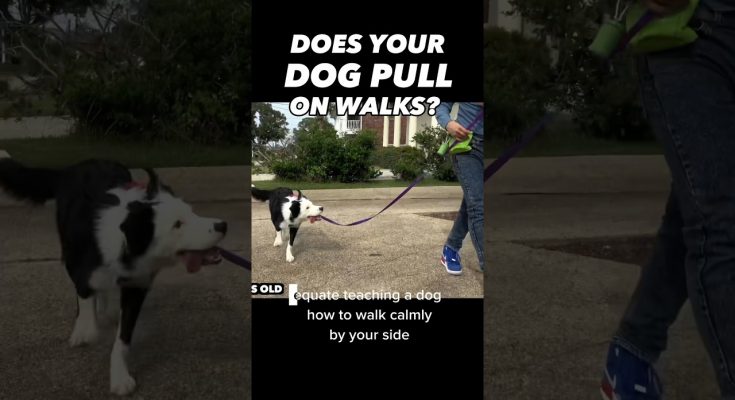Does your dog pull on walks?
Watch more of this video: https://youtu.be/tB4ocofBZc8
Follow for more ❤️
#dogtraining #dogtrainer #leashpulling #stoppulling #zakgeorge #dogtrainingrevolution #positivereinforcement #positivedogtraining #noshocknoprongnochoke #trainwithoutpain #moderndogtraining #noaversivesneeded #leashtraining #obedience #obediencetraining #beginnerdogtraining #easydogtraining #rescuedog #shelterdog #bigdog #positivedogtrainer #reactivedog #leash #pulling #dogtrainingtips #dogtrainingadvice #puppytraining #dogtraining101





Does your dog pull on walks?
Watch more of this video: https://youtu.be/tB4ocofBZc8
Follow for more ❤️
What do you recommend for apartment/condo dwellers who don’t have yards and will have to start leash walking from day one?
Leash walking is a critical skill with a lot of safety factors. Heel and loose Leash walking is 2 different things. And pulling can be stopped in days.
Just stop everytime there is tension on the lead or do a 180° turn. For heel have a treat in hand let puppy nibble on in while walking next to you. Short sessions of 2min at max will help teach the skill. Something else clam space every time your dog wants to go ahead of you stop get in front of them back them up with body pressure and then continue on your walk. O one more tip. Do fast past walking for your first walk of the day. This will drain the excitable energy while still keeping in mind if there is tension on the leash just stop wait and when the tensioner is released continue your speed walk.
I don’t teach heel. What I do teach is that if the dog pulls, then I stand still and it doesn’t get anywhere. I also teach “back” which is good for getting the dog away from a dangerous situation.
My wonderful dog Jasper had a problem wanting to dash quickly across roads. What I did was to give him the responsibility of looking after me to make sure it was safe for me to cross. He was a bigger than normal, very intelligent border collie and I trained him to be a walking assistance dog and other helpful things. His hobby was to make friends with people. He died a couple of months ago at the age of 15 and I haven’t got over it yet.
The stop and go method doesn’t work at all. The dog is still on the end of the leash in front, and is just confused on why you stopped following them because they are in the front on the end of the leash leading the walk. They are walking you and you’re just giving the message that you’re just stubborn and don’t want to keep up. This method only works if you do that, and then you turn and start walking the opposite way. That way, when they look back, they see that the thing that stopped them from moving forward, is you walking in the other direction. After a bit, they start to grasp that every time they pull, youre going to pull them a different direction so they may as well keep an eye on you so they don’t have to be stopped and pulled a different way. They can only progress on the walk if they are walking nicely on a loose leash beside you.
@Jasper Rodatz my dog understands perfectly that she has to wait for me before she can sniff that enticing gate post! I told her that I would make a bargain with her that I would wait for her (to finish sniffing) if she would wait for me and not pull me. So unless the smell is super enticing she walks brilliantly next to me with a loose lead and waits for me to get there while I wait for her whenever she wants to sniff.
I can’t turn and walk the other way because I use a walking frame. I had polio when I was a baby. My current dog is brilliant. She walks on my left normally which is my stronger leg and if the smell on the right is irresistible she will cross in front of my walking frame (checking on me first), have a sniff then back up into position on my left. She clearly understands our arrangement.
@Jasper Rodatz mind you, I giggled at the idea that a method doesn’t work when I have used it successfully for most of my life!
Zak perhaps you could help with an issue, what do you do with a puppy that wont stop chewing on things when your normal answer of distracting and redirecting doesnt work. Food and toys will not divert her attention and she will not go for other chewable objects. I have been trying to avoid physical corrections
Try satiation method, whenever the puppy gets something that its not supposed to chew on, give them a long lasting chew treat, a chew toy, or even better a combination of both like a kong filled with kibble and peanut butter (or any treats you have as long as they are not too high in fat) or a puzzle toy. If the puppy doesn’t seem interested in the item you choose to offer, make it fun by moving it around and making interesting sounds. This will activate their prey drive and hopefully make the item very interesting to them, even more interesting than the thing they weren’t supposed to chew on. You could also crate train so that you can crate them while you can’t keep your eyes on them constantly. Mccan dog training, Upstate canine academy, beckmans dog training, robert cabral, and American standard k9 here on YouTube are great sources for anything dog behavior and training One of them is bound to have a video on proper crate training.
I have one big question: I may train my dog for a while, which gives her a bit of exercise. But I still need to go for a proper walk where she can sniff etc and then we are straight back into old pulling habits. My dog has in more than 1.5 years not transferred to her walk what she learned in loose leash training sessions. I must say she gets very excited and also anxious when out and about which stands in the way of her learning. What to do?
Start implementing a “release” or “break” command while on walks where you’re heeling the dog. Heel for a few steps, and then release them to have a sniff, pull on the leash a little, and decompress a little. Then when you’re ready, bring them back into a heel, release them again if they are heeling nicely and have good engagement. Dogs have a threshold of how much “work” (listening and doing commands) so its important to give your dog breaks often even when you are working with them. For example, lets say you’re heeling your dog on a walk. They’re doing good, but then you notice maybe their attention starts to shift to something else other than you, or maybe they surge forward a little bit, or fall behind a bit, thats a sign that your dog has reached their “threshold” and need a break. Thats when you want to give them a release or break(you can also use free or whatever you want) so that they have time to decompress and “be a dog” so that they aren’t getting burnt out from constantly “working”. Its important that when you’re teaching a behavior such as heel, you gradually build up how long your dog heels for, rather than expecting your dog to heel 24/7 right after teaching the behavior. Gradually increase the time your dog is supposed to heel, but just make sure you’re giving them breaks when they start to become “sloppy” or have reached their threshold.
Also about the anxiety, work on your giving very clear, consitant communication with your dog. An example of this would be, being consistant about using the same tone for commands, same hand signals for commands, and making sure you let your dog know what is appropriate behavior and what isn’t. And finally, you yourself, need to be calm, confident and neutral in public. This will in turn make the dog understand clearly what is expected of them, what is appropriate to do in certain situations, and on top of that, your confidence and consistency in your training will build confidence in your dog as they know you can handle anything they are unsure of, and eventually will start looking up to you for guidance instead of making their own decisions that could possibly not be the best for them.
Thanks so much. I will work on that.
Cheers from New Zealand
@Ashapuri happy to help! Have a anxious dog myself so I understand the struggle. Best of luck to you and your pup!
Your method does not work.
You can teach a dog to walk beside you in 5 minutes. What are you even talking about saying its “difficult” its not difficult at all if you know anything about how to use leash pressure properly.
I wish you would go back and sho the steps to trying on loose, heel, pulling in one video, as you used to show us.These 2-3 minute video isn’t working for me. I feel you are jerking us around and I can’t get the steps organized enough in my head so I can present this new skill to my dog. If I can’t understand the steeps, how can I teach my dog?
All of my complete videos are available online any time you need to review!👍👍